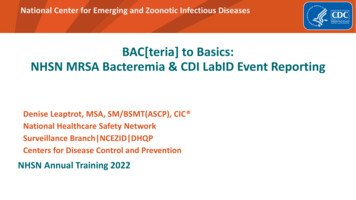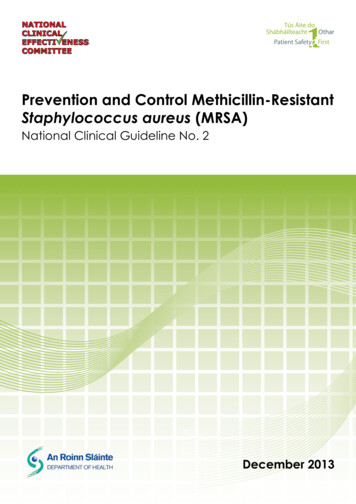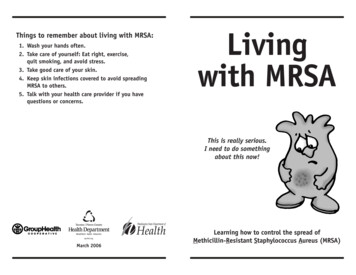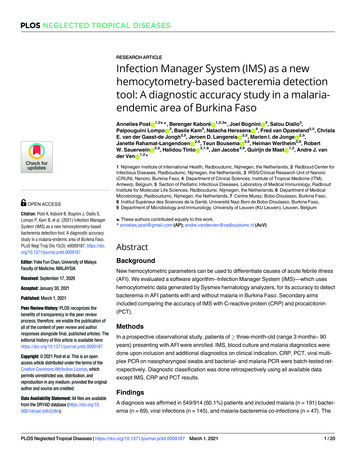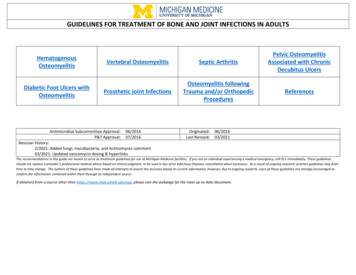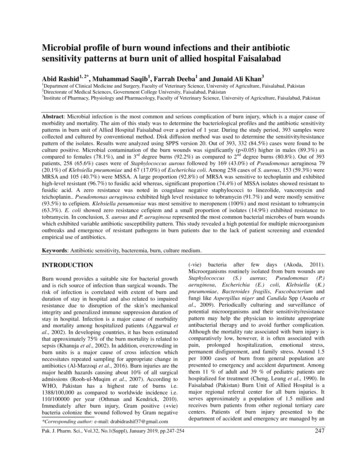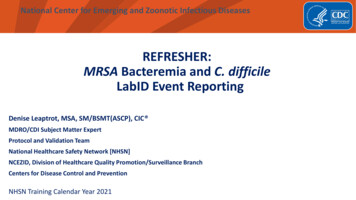
Transcription
National Center for Emerging and Zoonotic Infectious DiseasesREFRESHER:MRSA Bacteremia and C. difficileLabID Event ReportingDenise Leaptrot, MSA, SM/BSMT(ASCP), CIC MDRO/CDI Subject Matter ExpertProtocol and Validation TeamNational Healthcare Safety Network [NHSN]NCEZID, Division of Healthcare Quality Promotion/Surveillance BranchCenters for Disease Control and PreventionNHSN Training Calendar Year 2021
Key Concepts to LabID Event Reporting: Events are reported by patient AND location. An ‘inpatient’ is a patient housed on an inpatient location. An‘outpatient’ is a patient housed on an outpatient unit [such as the EDor a dedicated 24-hour observation unit]. Facility specific statusdesignations such as ‘observation’, ‘inpatient’, ‘outpatient’, ‘swingbed patient’ or ‘short stay patient’ do not apply for NHSN reporting. Hospital day 1 date admitted to facility [the calendar day thepatient locates to an inpatient location]. Time spent in the ED or on adedicated 24-hour observation unit is time prior to admission.
Key Concepts to LabID Event Reporting: LabID Event reporting is based strictly on laboratory testing data without clinicalevaluation of the patient, allowing for a much less labor- intensive method oftracking. Symptoms are NOT used in LabID event reporting. LabID Event reporting is by single facility; prior positives identified at a differentfacility will not influence reporting at your facility [reporting resets at newfacility]. ***the ‘Transfer Rule’ does NOT apply to LabID event reporting. LabID Events are attributable to the location where the positive specimen iscollected. The ‘LabID 14-day rule’ is location specific.
Special Case Exception for FacWideIN LabID Event ReportingSpecimens collected from an affiliated* outpatient location (excludingED and 24-hour observation locations) can be reported for the inpatientadmitting location IF collected on the same calendar day as inpatientadmission. Note: the ‘date admitted to facility’ is the calendar day thepatient locates to an inpatient location for the facility.*Affiliated outpatient location is an outpatient location where the samepatient identifier is used allowing for tracking of specimens acrossservices using the same patient number. In these ‘exception’ cases,attribute the event to the admitting location.
What’s the Location Have to Do With It?Inpatient Rehab/Inpatient Psychiatric Units NHSN considers transfers from an acute care inpatient unit to an inpatientrehab (IRF) and/or an inpatient psychiatric location (IPF) a continuous stay forNHSN reporting purposes. Facility admission date for a LabID event should reflect the date the patientwas physically admitted into either an acute care inpatient location or anIRF/IPF location whichever comes first during the patient stay.
Monthly Reporting Plan The Monthly Reporting Plan informs CDC which modules afacility is participating in during a given month. Referred to as “In-Plan” data The Plan also informs CDC which data can be used foraggregate analyses. This INCLUDES sharing applicable data with CMS! A facility must enter a Plan for every month of the year. NHSN will only submit data to CMS for complete months (data forall months of the quarter must be in place prior to submission).
Monthly Reporting Plan
Monthly Reporting Plan
Monthly Reporting Plan
Facility-wide Inpatient: FacWideINFacWideIN Standard Reporting Guidance:The first positive specimen for the patient AND the location issubmitted as a LabID event. Following this submission, there shouldbe 14 days between positive specimens in this location before anew LabID event is submitted (the LabID event 14-day rule). If thepatient moves to a new location, reporting resets (starts anew). Thisguidance applies to all inpatient locations in the facility, includinglocations with a different CMS Certification Number (CCN) such asinpatient rehab (IRF) or psych locations (IPF) as well as fromemergency departments and 24-hour observation locations.
Definition:MRSALabID Event
Must beUnformedStoolDefinition:C. DifficileLabID EventWhen using a multi-step testing algorithm for CDI on the sameunformed stool specimen, the finding of the last test performed on thespecimen that is documented in the patient medical record will determineif the CDI positive laboratory assay definition is met.
LabID Event Submission
Categorization of MRSA LabID EventsThe NHSN application automatically categorizes MRSA LabID Events as: Community-Onset (CO): LabID Event specimen collected in anoutpatient location or in an inpatient location 3 days after admissionto the facility [hospital days 1 (admission), 2, or 3] Healthcare Facility-Onset (HO): LabID Event specimen collected 3days after admission to the facility [on or after hospital day 4]
Categorization of C. Difficile LabID Events
Categorization of C. Difficile LabID Events
Reporting Denominator Data
Denominator Data: FacWideIN Line 1: Counts from all inpatient locations in the facility Line 2: Counts from all inpatient locations in the facility except CMS-certifiedRehab and Psych units (formerly labeled MDRO row 2) Line 3: Counts from all inpatient locations in the facility except CMS-certifiedRehab and Psych units, NICUs, and well-baby units (formerly CDI row 3)
Example: Incorrect Data Entry Line 2 and Line 3 refer to the total number of patients housed in inpatientlocations (FacWideIN) in your facility, regardless of the patient’s MDRO orC. difficile infection status (not diagnosis) ***Each denominator row should be a sub-set of the row above it
Denominator DataSelect CDI Test type quarterly (last month of each calendar-year quarter –March; June; September; December)
Denominator Data: Emergency Department / 24-hour observation On the summary data entry screen, use the ‘Location Code” drop down menu to selectED or 24-hour observation as the location for which you are entering the summary data.After selecting the appropriate unit, month, and year, one summary data field willbecome required (Total Encounters). Repeat steps for 24-hour observation locations.1 visit 1 encounter
Denominator Data: Report No Events If you have identified and reported any C. difficile LabID events during the month, you arefinished with your reporting for the month and can skip this step. If you have not identified any LabID events for C. difficile at the end of a month, you mustindicate this on the summary data record to complete your reporting efforts. On the MDRO and CDI Module summary data form, checkboxes for “Report No Events”are found underneath the patient day and admission count fields, as seen in thescreenshot below.If no LabID events are submitted forthe month, these boxes should be“checked” for each event you arefollowing “in-plan”. If these boxesare not checked, your data is notcomplete and will not be submittedto CMS.If you identify and enter LabID events for an organism after you’ve already checked the “Report No Events” box, the “Report No Events”check will automatically be removed in the NHSN database.
LabID Event or/index.html. Available for use with C. difficile and MDRO LabID Event reporting Aids in decision making around the 14-day rule External calculator
Are you viewing this training video during March 2021?Please submit questions to be answered during the live Q&A session. You canselect the title of the presentation and submit your question using the formlocated on the 2021 NHSN Training webpage.If you are viewing this training video after March 2021, please submit anyquestions about the content of the presentation to NHSN@cdc.gov.Additional NHSN training ng Questions: NHSNTrain@cdc.gov
Thank you for viewing this 2021 NHSNTraining presentation!For more information, contact CDC1-800-CDC-INFO (232-4636)TTY: 1-888-232-6348 www.cdc.govThe findings and conclusions in this report are those of the authors and do not necessarily represent theofficial position of the Centers for Disease Control and Prevention.
NHSN considers transfers from an acute care inpatient unit to an inpatient rehab (IRF) and/or an inpatient psychiatric location (IPF) a . continuous. stay for NHSN reporting purposes. Facility admission date for a LabID event should reflect the date the patient was physically admitted into either an acute care inpatient location or an
